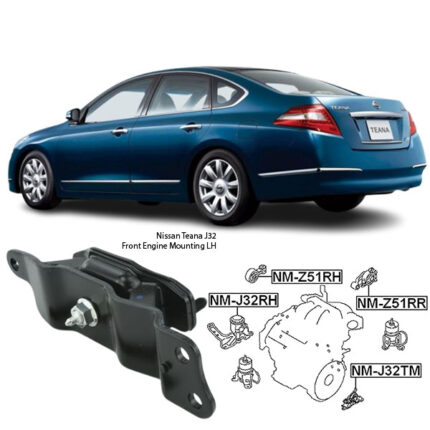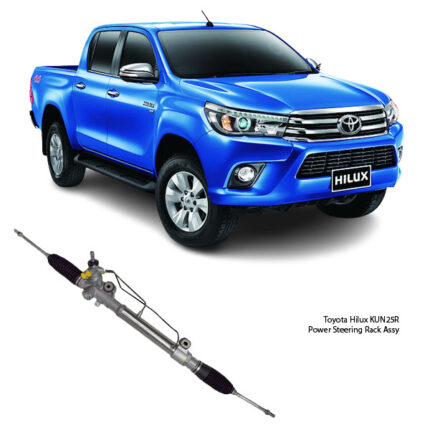-6%
Get Toyota Hilux KUN25R 4WD RHD Hydraulic Power Steering Rack Assy 44200-0k030 in Kenya
The Power Steering Rack Assembly is a critical part of a vehicle’s steering system, particularly in modern vehicles that rely on either hydraulic, electric, or electro-hydraulic power steering systems. This component is responsible for translating the rotation of the steering wheel into the lateral movement needed to turn the wheels. Without it, steering would be extremely difficult, especially at low speeds or when maneuvering a vehicle with heavy loads.
Main Functions of Power Steering Rack Assembly
-
Steering Control
Converts the rotational input from the steering wheel into linear motion, guiding the front wheels left or right. -
Assisted Steering
Works with hydraulic fluid pressure (in hydraulic systems) or electric motors (in electric power steering) to reduce the effort required by the driver when steering. -
Feedback to Driver
Provides road feel and feedback to the driver, helping them sense the road surface and vehicle handling characteristics.
Key Components of a Power Steering Rack Assembly
The assembly is a complex combination of several components, including:
-
Steering Rack
A metal bar with teeth that meshes with a pinion gear connected to the steering column. -
Pinion Gear
Converts the steering wheel’s rotation into lateral rack movement. -
Tie Rods
Connect the ends of the rack to the steering knuckles, transmitting the rack’s motion to the wheels. -
Hydraulic Cylinder (in Hydraulic Systems)
Assists the driver by applying hydraulic pressure to either side of the rack. -
Seals and Bushings
Maintain pressure, prevent fluid leaks, and allow smooth motion. -
Pressure Lines (in Hydraulic Systems)
High-pressure hoses that deliver power steering fluid to the rack. -
Steering Motor (in Electric Systems)
In Electric Power Steering (EPS), a motor directly assists rack movement.
Types of Power Steering Rack Assemblies
-
Hydraulic Power Steering Rack
Uses a hydraulic pump (powered by the engine) to generate fluid pressure that assists with steering. It’s effective but less efficient compared to newer systems. -
Electric Power Steering Rack (EPS)
Uses an electric motor to assist steering. It’s more efficient (no engine power loss) and offers adjustable steering feel. -
Electro-Hydraulic Power Steering
Combines hydraulic assist with an electric pump, useful in applications where compact design and efficiency are needed.
Working Principle of Power Steering Rack Assembly
Hydraulic Systems
- When the steering wheel is turned, the pinion gear rotates.
- The rotation moves the steering rack left or right.
- As the rack moves, hydraulic pressure is applied to one side of a piston inside the rack housing.
- This assistance pressure reduces the amount of force the driver needs to apply.
Electric Systems
- Sensors detect steering wheel rotation and vehicle speed.
- An electric motor, mounted on the steering rack, provides the appropriate level of assist.
- The motor applies force directly to the rack, reducing the driver’s steering effort.
Benefits of Power Steering Rack Assemblies
✅ Ease of Steering
Reduces driver fatigue, especially during low-speed maneuvers like parking.
✅ Improved Safety
Offers better vehicle control in emergencies.
✅ Enhanced Driver Comfort
Modern systems adjust steering assistance based on speed—lighter at low speeds, firmer at high speeds.
✅ Fuel Efficiency (with EPS)
Electric systems consume less power than traditional hydraulic pumps, improving fuel economy.
✅ Compact Design
Integrated steering assist systems save space, helping designers optimize engine bay layout.
Common Issues and Failure Symptoms
Despite being robust, power steering rack assemblies can develop problems over time:
-
Fluid Leaks (in Hydraulic Systems)
Leaking seals or hoses cause fluid loss, reducing steering assist. -
Stiff or Heavy Steering
Indicates loss of hydraulic pressure (hydraulic) or motor failure (electric). -
Unresponsive Steering
Worn gears, damaged racks, or broken tie rods can cause a loss of steering precision. -
Grinding or Knocking Noises
Usually due to worn bushings, gear damage, or lack of lubrication. -
Steering Pulling to One Side
Can occur if the rack is bent or if the power assist is uneven. -
Vibration in Steering Wheel
A damaged rack or loose tie rods can transmit road vibrations to the wheel. -
Warning Lights (in EPS Systems)
Modern systems will trigger a steering system warning light if electronic faults are detected.
Causes of Power Steering Rack Assembly Failure
- Contaminated Fluid (Hydraulic systems)—Debris can wear seals and gears.
- Corrosion and Rust—Moisture ingress can corrode internal components.
- Impact Damage—Hitting potholes, curbs, or road debris can bend or crack the rack.
- Lack of Maintenance—Failing to replace power steering fluid causes seal deterioration.
- Overloading or Off-road Use—Excessive loads stress the rack beyond design limits.
Maintenance Tips for Long Life
-
Regular Fluid Checks (Hydraulic Systems)
Use the correct type of power steering fluid and change it at recommended intervals. -
Inspect for Leaks
Periodically check around the rack housing and hoses for fluid seepage. -
Alignment and Suspension Checks
Misaligned wheels or worn suspension parts increase stress on the rack. -
Avoid Excessive Steering at Full Lock
Holding the wheel at full lock for extended periods strains the system. -
Replace Worn Tie Rods and Bushings
Loose or worn parts affect steering feel and rack lifespan. -
Monitor Warning Lights (EPS Systems)
Address electronic faults immediately to avoid rack damage. -
Protect Against Corrosion
If you drive in harsh environments (salted roads, off-road), wash the undercarriage regularly.
Replacement and Repair
When a power steering rack assembly fails, repair is sometimes possible, but often replacement is the better option, especially for modern vehicles with integrated electric assist. When replacing, ensure:
- The new rack matches the vehicle’s specifications.
- Tie rods and other connected parts are inspected and replaced if necessary.
- Proper bleeding procedures (for hydraulic systems) or calibration (for EPS) is followed.
- A wheel alignment is performed after installation.
Cost Considerations
- Hydraulic power steering racks are typically less expensive than EPS units.
- Labor costs can be high due to the rack’s location (often buried deep in the engine bay).
- OEM racks tend to be more costly than aftermarket options, but they offer better fit and reliability.
Conclusion
The Power Steering Rack Assembly is one of the most important components of modern steering systems. Whether hydraulic or electric, it plays a crucial role in ensuring a vehicle can be maneuvered with minimal effort while providing the driver with valuable feedback from the road. With regular maintenance and careful driving, a quality steering rack can last over 100,000 kilometers, delivering safe and reliable performance.
Follow us on Facebook for more parts.




Reviews
Clear filtersThere are no reviews yet.